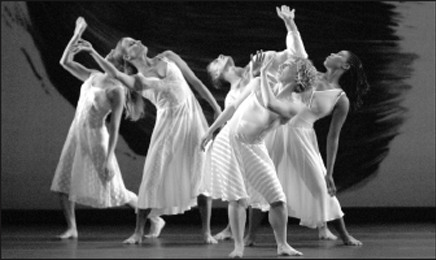By Rebecca Milzoff
Like the majority of Mark Morris’s work, music is paramount in Mozart Dances. A sixteenth-note run is articulated by pitter-pattering feet, a trill embodied with a run of chainé turns. But in this work in particular — performed to an ecstatic audience for the second year in a row at the New York State Theater — the notes played become more than a template to which the choreographer attaches steps. They morph into an actual physical presence, tangible in the empty spaces between Mr. Morris’s talented dancers.
This is made all the more intriguing by the choice of music: three of Mozart’s piano solos, played with precision and understated grace by Emanuel Ax (and, on a double concerto, with his wife Yoko Nazaki). These works don’t provide the freest of structures within which to work — other than a cadenza here and there, they are masterpieces of tick-tock formality — but Mr. Morris somehow manages, on most occasions, to make these pieces seem simple, natural choices for effortless, flowing movement.
“Eleven,” set to the Piano Concerto No. 11 in F Major, demonstrates this beautifully. Against a stark white backdrop accentuated by three broad, black brushstrokes, the women of the company take center stage, in dress well-suited to the feel of the piece — black bras and briefs under sheer gray dresses, suggesting harshness and femininity in coexistence. Likewise, Lauren Grant —a tiny, pixie-ish blond of admirable strength — delicately scampers and spins on and offstage, while the other women bounce in relevé, their arms bent behind their heads in a starkly authoritative position, or cutting through the air. Ms. Grant sometimes seems to be at once running away from the other women and navigating their group, trying to find a way in, only to watch them stomp off-stage in trademark Morris fashion.
That tension continues into the next piece, “Double,” reaching an almost tragic level. It begins as a man dressed in a deconstructed, open frock coat dances alone. He ventures in from off-stage and exaggerates courtly postures in his steps, only to march offstage just as quickly. Joe Bowie, the dancer, expertly combines a refined elegance and hint of animalistic brutality in this role, which turns darker in the slow second movement, a brooding andante. Mr. Bowie keeps to the edges of a group of men who partner Noah Vinson, a lanky, extremely boyish dancer who is lifted as if ascending to heaven by the other men. As Mr. Vinson, exposed in a light blouse, slowly turns within a circle of the men, Mr. Bowie mimics his movements from the circle’s outside, and the women, in gauzy skirts reminiscent of the Wilis in “Giselle,” join in. It’s the most powerful moment in the evening. There is no real story, but we are overtaken by an immense sense of sadness and perhaps doom for Mr. Vinson — one which, despite the cheerful essence of the last movement, doesn’t quite subside.
Thankfully, an intermission allowed for some dissipation of “Double”’s mood before the final dance, “Twenty-Seven,” set to the exuberant Piano Concerto No. 27 in B flat major. Here more than ever, Mr. Morris’s entire ensemble, clad in white, seem to be buoyed along by the lilting strains of the piano. They appear as a whole group only momentarily, otherwise occupying only portions of the stage, as couples dance down a diagonal in promenade fashion, or whirl on and off the peripheries. It’s as if they’re making room for the piano lines, skipping along with them, even chasing them at points.
There’s an air of carefree innocence here that is hard to resist, and in this Mr. Morris succeeds the most. At the end of “Twenty-Seven,” a group of dancers onstage gesture to a group half on, half off, with expectant arms, as if pleading; in return, their counterparts ecstatically clasp their hands to hearts before the lights go out. The audience audibly gasps with glee at this moment, and for good reason. Using what may seem the simplest of music and movements, Mr. Morris has imbued with these dances with evocative, mysterious delight.
Using what may seem the simplest of music and movements, Mr. Morris hasimbued these dances with evocative, mysterious delight.


































